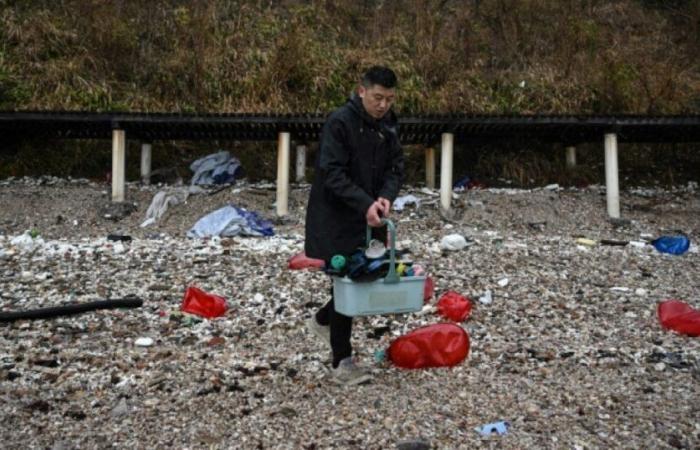Under a sky filled with threatening clouds on an isolated beach on the Chinese islands of Miaodao, the artist Fu Junsheng walks between piles of plastic waste washed up on the shore, in search of inspiration.
China is the world’s largest producer of plastic, and the Miaodao Islands, located at the intersection of several industrialized coastal areas, face continuous waves of floating trash washing up on its beaches.
Eight years ago, the artist Fu Junsheng decided to make it both his artistic raw material and an awareness tool.
“Our generation has experienced dazzling development, but we have often neglected, or even completely forgotten, nature in this process,” he explains to AFP, walking through his workshop where works created from plastic are piled up. collected on the beaches.
Among his most impressive works is an installation made up of nearly 900 worn sandals, piled up in front of seascape canvases.
“(This waste from the sea) bears the trace of our daily lives, of the lives of each of us,” he underlines.
The oldest object he collected was a packet of instant noodles from 1993, which remained almost intact despite decades spent in the wild.
“These objects do not disappear, but fragment into microparticles which can be ingested by marine fauna, then end up on our plates,” warns the artist, adding that “this process is invisible to the naked eye”.
– “Collective challenges” –
The Miaodao Islands lie opposite the Korean Peninsula, where delegates from more than 170 countries are working this week to conclude a treaty on reducing plastic pollution.
Fu Junsheng regularly finds lighters and bottles from South Korea.
“Protecting marine ecosystems requires international cooperation,” he says, because “it is not a local issue, but a global problem.”
At Qingdao University, Fu Junsheng became interested in the environmental consequences of China’s rapid urbanization that began in the late 1980s.
In 2023, Chinese factories produced 75 million tonnes of plastic, according to official figures.
China is not considered the world’s largest plastic polluter, but it still generated 63 million tonnes of waste in 2022, according to state media.
Around 90% was recycled, buried or incinerated – in similar proportions – but 7% was directly released into nature.
For Fu Junsheng, completely eliminating plastic is unrealistic, but he calls for “more controlled and more reasoned” use.
Globally, more than 90% of plastics used are not recycled. Every year, 20 million tonnes end up in nature, often just minutes after use.
“People often approach these problems on an individual scale. But environmental issues are collective challenges for all of humanity,” insists the artist.
– Daily products –
Over the years, Fu Junsheng has collected countless items: toys, balloons, toothbrushes, bottles… All are everyday products.
Its objective is to show to what extent marine pollution is directly linked to our consumption habits.
Among his works published online are a rainbow made from fragments of colored plastic, or a deflated inflatable doll, surrounded by multi-colored rubber gloves.
Another installation depicts a shelf filled with waste cosmetic bottles and beauty products.
“These products are supposed to make us cleaner and more beautiful,” notes Fu Junsheng.
“And yet they often end up in the ocean, where they pollute water, destroy marine ecosystems and ultimately disfigure our environment.”






